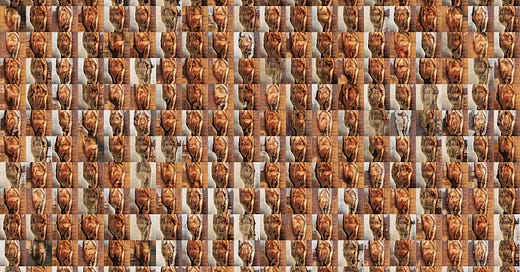⚫️ Robbie Barrat: the AI pioneer who is redefining the future of art
In a world where technology and creativity are converging at an unprecedented rate, one name stands out as a key figure in the exploration of artificial intelligence and digital art: Robbie Barrat. At just 22 years old, Barrat is pushing the boundaries of what we define as art through his groundbreaking work with Generative Adversarial Networks (GANs), a cutting-edge form of AI that allows machines to create art. With his work now being sold as high-value NFTs (Non-Fungible Tokens), Barrat is emerging as a revolutionary artist who is shaping the future of both the art and tech worlds.
Barrat's journey began at the age of 17 when he first started experimenting with AI, using GANs to generate art that challenged traditional artistic methods. GANs work by utilizing two neural networks in a kind of "duel": one network generates images, while the other critiques and refines them. This process, which essentially trains the machine to "learn" from its mistakes, allows Barrat to create hyper-realistic, often surreal imagery that blurs the line between human and machine-made art.
Barrat's breakthrough came when he began creating portraits using this AI process. His series of "AI-generated nude portraits" has been met with both acclaim and controversy. These pieces, created by an algorithm rather than a human hand, explore the intersection of technology, identity, and body representation. The portraits are mesmerizing and unsettling at the same time—evoking beauty while raising questions about the role of technology in artistic creation.
For Barrat, the potential of AI goes far beyond just creating visually striking works. It represents a new era in which machines are not only tools but co-creators in the artistic process. He views his relationship with AI as a collaboration, where the machine has its own autonomy and voice. “The AI makes decisions that I wouldn’t have thought of,” Barrat says, highlighting the surprising and unpredictable nature of the creative process. This collaboration challenges traditional notions of authorship and creativity, which have historically been dominated by human artists.
In recent years, Barrat’s work has gained traction within the NFT community, where digital artworks are bought, sold, and traded as unique tokens on the blockchain. The rise of NFTs has provided Barrat with a platform to showcase his creations to a global audience, while also giving him the opportunity to monetize his innovative approach to art. His works have sold for significant amounts, reflecting not only the growing demand for digital art but also the increasing recognition of AI as a legitimate medium of artistic expression.
Despite the success, Barrat remains a figure of intrigue and mystery. The question of whether AI can truly create art in the same way humans do is still hotly debated. Critics argue that art is inherently tied to human experience and emotion, something that an algorithm cannot replicate. Others, however, see Barrat’s work as a profound reflection of the ever-evolving relationship between technology and creativity, suggesting that AI could be the next great frontier in the history of art.
For Barrat, the possibilities are endless. He continues to refine his techniques, experimenting with new forms of AI-generated art that challenge conventional aesthetics and cultural norms. One of his more recent projects explores the creation of dream-like landscapes, using GANs to generate entire worlds that feel both alien and familiar. These digital landscapes, like his portraits, invite viewers to question what is real and what is artificial, reflecting the blurred lines of the modern technological age.
Looking ahead, Barrat’s work will undoubtedly continue to inspire and provoke. As AI technology advances, so too will the potential for artists like Barrat to push the limits of what we think is possible. Whether or not AI-generated art ever replaces human creativity remains to be seen, but one thing is certain: Robbie Barrat is at the forefront of a new era in art, and his work will continue to challenge, disrupt, and redefine the future of artistic expression.
Robbie Barrat, born in Dublin in 1999 and raised in West Virginia, is a digital artist known for his work with Generative Adversarial Networks (GANs). After high school, he worked at NVIDIA and conducted bioinformatics research at Stanford but ultimately pursued his passion for art, enrolling in a European art school.
Barrat uses AI and GANs to explore fashion, architecture, and art history, viewing AI as both a tool and art form. His early works investigated AI's role in art, contextualizing its misinterpretations and potential within art history.
In 2018, he created The Lost Robbies, a sought-after series of 300 AI-generated nude portraits. His recent work integrates AI as part of a broader creative process, rather than its sole focus.
On July 17, 2018, Christie’s hosted its first Tech Summit in London, shortly after the launch of the NFT marketplace SuperRare. SuperRare partnered with Christie’s to demystify AI art, enlisting Robbie Barrat, the first artist to tokenize art on the platform, and collector Jason Bailey to create a unique artwork for the event.
Barrat minted 300 frames of “AI Generated Nude Portrait #7” using DCGAN, a machine learning technique trained on 250,000+ WikiArt images to emulate various art styles. These frames, redeemable as ETH gift cards, were sold individually as part of a single artwork.
While the process showcased AI's potential in art, most attendees failed to grasp its significance. As a result, 288 frames went unredeemed, now famously known as “The Lost Robbies.”
On March 2nd 2022, just one of those artworks, “AI Generated Nude Portrait #7 Frame #64”, was sold at Sotheby’s for over $800,000.
The “Lost Robbies” phenomenon highlights a significant aspect of contemporary discourse, showcasing the deep intersection of AI, NFTs, and the art world.
More info:






